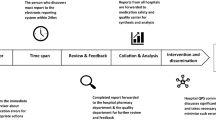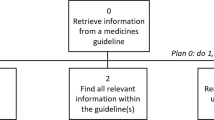Abstract
Background
Medication error reporting systems in hospitals are faced with the challenge of processing vast numbers of reports which identify a myriad of safety issues. With such large volumes of data and limited resources it makes sense to adopt a prioritisation approach. Several published studies have focused solely on the subset of errors which cause patient harm. The majority of such research has concerned the individual analysis of criteria associated with medication errors. However, the research described here used an alternative approach which involved linking the three criteria of medication class, patient outcome, and type of error, in order to describe the medication-related scenarios presenting greatest risk to the organisation.
Aims
To identify the highest-priority medication-related risks in an acute teaching hospital. To profile harmful medication errors submitted to a voluntary reporting system in a tertiary healthcare setting in Ireland.
Methods
A database of medication errors, reported via an internal voluntary reporting system over a 5-year period, was analysed. The criteria of medication class, patient outcome and type of error were analysed separately and then cross-tabulated.
Results
The medication classes, error types and adverse patient outcomes most frequently associated with harm were identified. The cross-tabulation highlighted ten priority risk areas which accounted for the majority of patient harm.
Conclusions
A cross-tabulation strategy for prioritising medication-associated risks was successfully applied to a hospital database comprising medication errors. The profile developed for harmful medication errors in this acute tertiary healthcare setting was broadly in line with that published for error reporting systems internationally.


Similar content being viewed by others
References
Kohn LT, Corrigan JM, Donaldson MS (eds) (1999) To err is human: building a safer health system. Institute of Medicine, Washington DC
Kanjanarat P, Winterstein A, Johns T, Hatton R, Gonzalez-Rothi R, Segal R (2003) Nature of preventable adverse events in hospitals: a literature review. Am J Health Syst Pharm 60:1750–1759
Standard MM.7.10 The organization develops processes for managing high-risk or high-alert medications. New JCAHO medication management standards for 2004: changes related to high-risk medications. Available at: http://www.medscape.com/viewarticle/482368_11
ACHS Evaluation and Quality Improvement Program (EQuIP) 4 Guide, Part 1: Accreditation, standards, guidelines. July 2006
(2006) Top 10 drugs reported as causing harm through medication error. ISMP-Canada bull. 6(1). Available at: http://www.ismp-canada.org/download/safetyBulletins/ISMPCSB2006-01Top10.pdf
(2007) Safety in doses: medication safety incidents in the NHS. In: Fourth report from the Patient Safety Observatory. National Patient Safety Agency, London. Available at: http://www.nrls.npsa.nhs.uk/resources/?EntryId45=59822
(2007) Safety in doses: improving the use of medicines in the NHS. In: Learning from national reporting. National Reporting and Learning Service. National Patient Safety Agency. Available at: http://www.nrls.npsa.nhs.uk/resources/?entryid45=61625
Bates D, Cullen D, Laird N (1995) Incidence of adverse drug events and potential adverse drug events; implications for prevention. J Am Med Assoc 274:29–34
Winterstein A, Hatton R, Gonzalez-Rothi R, Johns T, Segal R (2002) Identifying clinically significant preventable adverse drug events through a hospital’s database of adverse drug reaction reports. Am J Health Syst Pharm 59(18):1742–1749
Winterstein A, Johns T, Rosenberg E, Hatton R, Gonzalez-Rothi R, Kanjanarat P (2004) Nature and causes of clinically significant medication errors in a tertiary care hospital. Am J Health Syst Pharm 61(18):1908–1916
Clinical Indemnity Scheme. Available at: http://www.stateclaims.ie/ClinicalIndemnityScheme/introduction.html
(2008) STARSWeb evaluation project: a report from the Health Service Executive, the Health Information and Quality Authority, and the State Claims Agency. Available at: http://www.hiqa.ie/media/pdfs/HIQA_STARSweb_Report_2008_07_10.pdf
STARSWeb statistics 2009. Clinical Indemnity Scheme. Available at: http://www.stateclaims.ie/ClinicalIndemnityScheme/starswebStats.html
Kirke C, Tighe P, Colohan G, Harnett B, Creaton G, Delaney T (2007) A collaborative study of medication safety in four Irish hospitals. Irish Pharm J 85(2):68–73
Kirke C (2009) Medication safety in hospitals. Ir Med J 102(10):339–341
World Health Organization Anatomical Therapeutic Chemical (ATC) classification system. Available at: http://www.whocc.no/atc_ddd_index/
National Coordinating Council for Medication Error Reporting and Prevention (NCC MERP). Available at: http://www.nccmerp.org/
What is a medication error? National Coordinating Council for Medication Error Reporting and Prevention, Rockville. Available at: http://www.nccmerp.org/aboutMedErrors.html
World Health Organization (2009) More than words: conceptual framework for the international classification on patient safety. In: Final technical report (v. 1.1): Geneva. Available at: http://www.who.int/patientsafety/taxonomy/icps_full_report.pdf
MedMARx 2003 data report; a chartbook of 2003 findings and trends 1999–2003. Available at: http://psnet.ahrq.gov/resource.aspx?resourceID=1330
Cohen M, Smetzer J, Tuohy N, Kilo C (2006) High-alert medications; safeguarding against errors. In: Cohen M (ed) Medication errors, 2nd edn. American Pharmaceutical Association, Washington DC, pp 317–412
Conflict of interest
None.
Author information
Authors and Affiliations
Corresponding author
Rights and permissions
About this article
Cite this article
Relihan, E.C., Ryder, S.A. & Silke, B. Profiling harmful medication errors in an acute Irish teaching hospital. Ir J Med Sci 181, 491–497 (2012). https://doi.org/10.1007/s11845-012-0804-y
Received:
Accepted:
Published:
Issue Date:
DOI: https://doi.org/10.1007/s11845-012-0804-y




